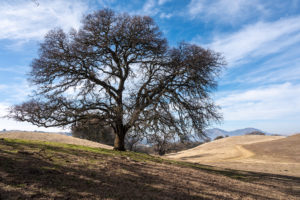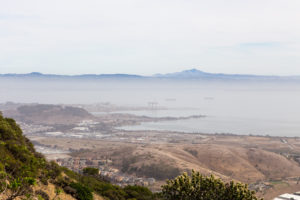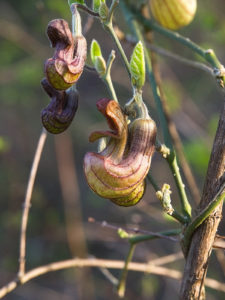In 1769, when the Spanish soldiers of the Gaspar de Portola expedition viewed the San Francisco Bay for the first time, they saw but a small portion of a vast grassland that once surrounded the Bay and clothed the valleys and eastern hills. A good two-thirds of Alameda and Contra Costa Counties were once occupied by open grasslands and rolling oak savannas. From the crest of the Berkeley Hills to the naked foothills overlooking the San Joaquin Delta and from the south shores of the Sacramento River to the Ohlone Wilderness, this landscape still defines the East Bay experience. The rolling hills and ridges glow green in the spring and golden brown in the summer, dotted with oaks and patches of shaded woodlands on eastern slopes and in canyons. On a brisk spring day when our grasslands are green and soft, they appear boundless, rolling with quick waves in the wind, as hawks soar above. Later in the year, summer’s golden brown reminds us that our grasslands endure almost six months of drought, the longest sustained dry period of any Mediterranean climate region in the world. Get off the beaten track in the dry season, and your socks and shoelaces will quickly become magnets for the sharp stickery seeds of introduced European annual grasses and thistles that now dominate our grasslands. Stop for a moment, and you’ll hear the crickets punctuating the quiet and the faint sound of the dry grass rustling in the wind.
The change of the California grassland landscape from one dominated by native perennial grasses to that of annual Mediterranean grasses is perhaps one of the quickest and most complete type conversions of any plant community known. Though theories abound, we don’t yet fully understand how this came to pass. But there is one thing we do know for sure: The heritage of our grassland is a story of grazing, fire, and drought coupled with the epoch-making introduction of the Mediterranean grasses.
Before this invasion, the Bay Area’s native grasslands were shaped by the grazing of vast herds of tule elk that frequented both the coastal and inland corridors from Santa Rosa to the Salinas Valley, while fleet-footed pronghorn antelope browsed the drier inland grasslands of the San Joaquin and Sacramento Valleys. Pursuing the elk were Native American hunters, mountain lions, jaguars, and grizzly bears. Fresh, abundant forage was often heavily grazed by elk, but the elk would keep moving, always wary of the hungry predators and human hunting parties stalking in the distance. It is likely the grazed bunchgrasses and herbaceous flowering perennials had plenty of time, perhaps a whole growing season, to regain their vigor before the elk returned. The California tule elk persisted until the late 1870s, serving as a major source of meat and leather for the forty-niners before being hunted almost to extinction.
The early Spanish explorers found a landscape often consumed by fire. While the frequency of fire prior to the entrance of Europeans is difficult to determine precisely, there is good evidence from redwood fire scars that large-scale fires occurred naturally in central California in 10- to 12-year intervals. During prime fire weather in the late summer and early fall, fires could burn unchecked for days or weeks, thoroughly consuming areas the size of two or more present-day counties. And not all of these fires resulted from lightning strikes. Native Americans periodically set fires to encourage the growth of some of their most vital foods, including the seeds of grasses and wildflowers used for pinole, a mixture of ground seeds that was a staple of the Native American diet. After the seed was collected and the game had moved on to late-season pastures, native people burned areas every two or three years to encourage the production of favored seed for the following year. In addition to encouraging plants like red maid, savored for both its juicy herbage and its nutritious black seeds, this practice also opened up overgrown brush and chaparral. This improved the habitat for prime game like deer, rabbits, and quail.
Both grazing and fire consumed and recycled the productive vegetation of the grassland, making room for a diverse assemblage of wildflowers, keeping brush in check, killing encroaching oak seedlings, and quickening the regrowth of the perennial grasses and wildflowers. Both the grazing and the late-summer fires were most likely quick and thorough, followed by periods of regrowth and renewal. Grasslands that have been recently grazed will not burn as hot or as thoroughly as an ungrazed grassland. Over time, the interaction of grazing and fire produced myriad combinations of fire intensities, seasons, and durations based on weather patterns and the behavior of grazing animals and their predators.
California’s original coastal and inland valleys and hills were clothed by perennial bunchgrasses with abundant annual and perennial wildflowers. The two basic native grassland types found in the East Bay are coastal prairie and foothill grassland. Close to the ocean, under the influence of cool maritime temperatures and daily summer fogs, many parts of the coastal prairie could remain green and succulent until midsummer. In the East Bay, the coastal prairie was primarily found along the crest of the Berkeley and Oakland Hills and the plain extending down to the Bay shore. The grasslands and savannas of the inland valleys and foothills are known as the valley or foothill grassland. The foothill grassland is a diverse grassland community interspersed with savanna, woodland, scrub, and chaparral plant communities on a variety of soils and exposures.
The pristine coastal prairie was a perennial landscape dominated by long-lived bunchgrasses and herbaceous flowering perennials. Significant parts of these lands could stay green through much of the year and were the likely preferred summer range of the tule elk. Early accounts of the Berkeley plain speak of vast stands of California oatgrass (Danthonia californica), the signature bunchgrass of the coastal prairie. As far as the coastal fog could reach inland beyond the first ridge, California oatgrass reigned. It is a very sweet, palatable grass with a tough crown rooted firmly in the earth. Under heavy grazing pressure, dense stands of California oatgrass can almost form sod, a rare trait among bunchgrasses.
Remnants of the coastal prairie can still be found on open space lands at Point Pinole, the Potrero Hills north of Point Richmond, on the ridgetops of the Berkeley Hills, and on a unique serpentine ridge along the western margin of Redwood Regional Park adjacent to the old East Bay Regional Park District Headquarters. Point Pinole Regional Shoreline has one of the best mixed stands of California oatgrass and purple needlegrass (Nassella pulchra) on the East Bay shore. Miller/Knox Regional Shoreline, on the Potrero Hills ridgetops and shore, has inviting pure meadows of the native creeping coastal bentgrass (Agrostis pallens) and a prosperous association of native perennial grasses, including a unique bluish, drought-tolerant variety of red fescue, locally known as the Molate fescue (Festuca rubra). At the University of California’s Richmond Field Station, two city blocks containing one of the most splendid stands of coastal oatgrass prairie miraculously escaped annihilation when a housing development was halted shortly after the sidewalks were built in the early 1940s. This tiny area is the very last untouched postage-stamp patch of the California oatgrass prairie that once covered the East Bay hills.
East and south of the Berkeley-Oakland Hills, the maritime influence is lessened, leaving behind the coastal prairie and moving into the interior foothill grassland, a drier landscape with ample fuel for late-season wildfires. Today this is the undisputed realm of the introduced annual grasses. The composition of the pristine foothill grassland is more difficult to reconstruct than that of the coastal prairie because there is so little left, and few historic records describe its makeup in detail. So a journey to our native interior grasslands is one that must be taken largely in the imagination, based on a few clues gleaned from what we know about the plants and where they are found now.
To search for these clues for yourself, go out to the East Bay’s open space parks, park your car or lock up your bike, and strike out on the less beaten open space trails. Keep a keen eye out, and suddenly there they are: the surviving pieces of our native landscape. Here, a patch of California melicgrass (Melica californica) and there, several small bunches of bluegrass (Poa secunda) clinging to a rocky slope. The erect, narrow flowering stems of blue wildrye (Elymus glaucus) are easy to spot, most likely in the shady understory of some oaks or in an inviting clearing. You can positively identify the dark green clumps of purple needlegrass when the needle-like awns emerge with their purple cloaks. Come back in June and a new native bunchgrass may be poking several compressed flowering heads in the air. It must be junegrass (Koeleria macrantha). And what’s that bushy grass over there? That must be the aptly named squirreltail (E. multisetus).
These are just a few of the many species that made up a rich tapestry whose exact warp and weft we can only guess at. In the mid-1860s, William Brewer, one of California’s earlier botanical explorers, called the grasslands of the broad valleys of the Central Coast range the “pingrass prairie,” distinguishing purple needlegrass as the most likely component of the foothill grassland. This long-lived, deep-rooted bunchgrass may very well have been the dominant grass of the sunny valleys and hills, growing in rich adobe soils. In many ways purple needlegrass typifies the classic bunchgrass of California’s foothill grassland open space. Today it is the undisputed candidate for official state grass.
The tall blue wildrye is undoubtedly the bunchgrass the first Spanish explorers saw growing as high as the flanks of horses; it was probably one of the primary native grasses used for pinole. Closely associated with woodland meadows and open stands of deciduous oaks, it grows in many forms, from tall specimens suited for shady woodlands, to leafy, sprawling forms in open meadows or on hilltops and north-facing slopes.
One of the more widespread native bunchgrasses of the drier, less fertile interior grasslands is one-sided bluegrass or malpais bluegrass. It is a short perennial bunchgrass with a shallow, fibrous root system. It survives the long dry season by completely shutting down as soon as the ground begins to dry out. Malpais bluegrass is the earliest native perennial grass to green up in the winter and is very attractive to grazing animals, both small and large. Even as their basal leaves are eaten close to the crown or withered and brown from drought, their flowering stems stand green and erect with still-ripening seed.
Another important native grass from the drier foothill range is California melicgrass, which may well have been the most widespread native perennial grass of the interior plains and hills. With its graceful stems and silvery seed heads, California melicgrass is one of the most beautiful of our native grasses. Like the bluegrass, it turns completely dormant in the late spring. California melicgrass grows on the richer soils and is larger and more productive than the bluegrass. It is not a strict bunchgrass, but rather spreads underground, forming a swollen bulb at the base of the flowering stem, which gives rise to new buds after the plant has been grazed. It is a tasty and nutritious grass and likely provided substantial early spring forage for migrating tule elk.
As you go searching for these native grasses, you’ll see firsthand that the introduction of the Mediterranean annual grasses is the juggernaut that has forever changed the balance and composition of our grasslands. The Spanish and subsequent settlers who followed the Portola expedition brought along a parade of annual grasses and weeds. The seed came stuck to the hides and wool of the livestock and from imported feed and ballast accompanying the new livestock in ships’ holds. Beginning with wild oats, waves of new annual grasses arrived in California one after the other. After the oats came ripgut, then the annual foxtails, Italian ryegrass, rat-tail fescue, soft chess, cheatgrass, the dreaded medusa-head, and the most recent arrival, barbed goatgrass.
The Mediterranean annual grasses grow faster and bigger than the native bunchgrasses. Established annual grass stands produce ten times the amount of seed as do native grass stands of equal area, and most important, their seeds are five to ten times larger, giving them a big jump on establishment and fast growth. Another advantage they have is their shallow, weblike root system, which quickly exploits the moisture near the surface of the soil, rendering tiny, slow-growing native perennial seedlings helpless. The competitiveness of the annual grasses has also curtailed the spectacular wildflower shows of times past. Ironically, problems exacerbated by grazing are not necessarily solved simply by excluding livestock. Total rest from grazing can lead to a downward spiral of plant and animal diversity and the actual loss of healthy grasslands to brush or vast fields of grayish thatch, the undecomposed litter of previous seasons’ growth. In fact, colorful native wildflower displays are more often found where moderate livestock grazing reduces the annual grasses’ competitive edge.
But the Mediterranean annual grasses are a permanent part of the Californian grasslands, and they now are as much a part of California’s grasslands as the native perennial grasses once were. The time is long overdue for an official naturalization ceremony. Despite the losses suffered by native plants in the face of exotic grasses, the East Bay annual grasslands remain a tremendously productive ecosystem, in terms of producing great volumes of both forage and seed. On fertile soils, up to 26,000 pounds per acre of dry plant litter are produced annually. Depending on the composition of a particular grassland community, between 8,000 and 65,000 germinable seeds in a square meter have been counted. This bountiful harvest supports many hundreds of voles, mice, or ground squirrels per acre, which in turn are the primary prey for snakes, kit fox, coyote, bobcat, and a wide variety of raptors.
We may never return to the lost perennial grasslands shaped by the interplay of wildfires, grazing elk, and plentiful predators. But we can learn from these interactions to form our own models of grassland stewardship. Though much study and research will be needed to determine the unique management practices that will best fit each site, grazing and fire clearly have a critical role to play. Today, park managers are trying to come up with practical ways of mimicking the processes that can encourage native perennial bunchgrasses and the diversity of wildflowers without impractical measures such as reintroducing free-ranging elk or letting wildfires burn.
This is no simple matter. There is a real history of damage that inappropriate ranching has done across the West, and that must be acknowledged. The East Bay Regional Park District and others are pioneering stewardship grazing practices including livestock rotation and seasonal grazing, and these have enhanced wildflower diversity and may help threatened species like the red-legged frog. Such sophistication is the norm for ranchers like Duane Martin, at Black Diamond Mines Regional Preserve, or Joe Morris, who runs cattle on two state parks (see “First Person,” page 5). Much more than simply keepers of livestock, ranchers can become stewards, working with biologists and local park managers to make sure that our grasslands remain healthy for a long time to come.

.jpg)



